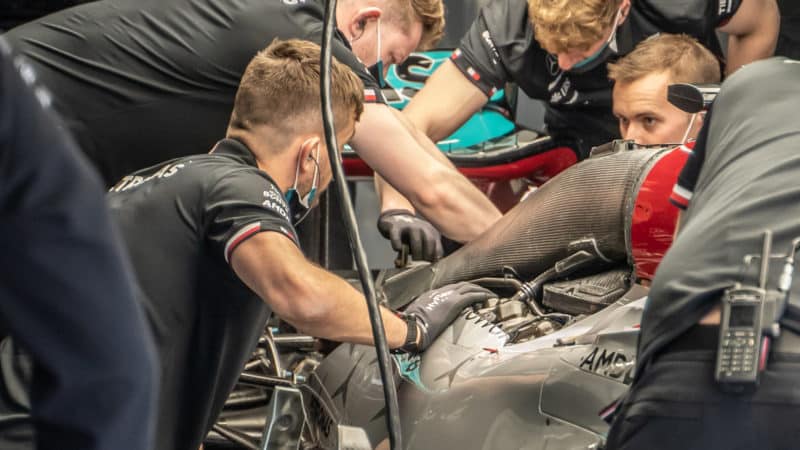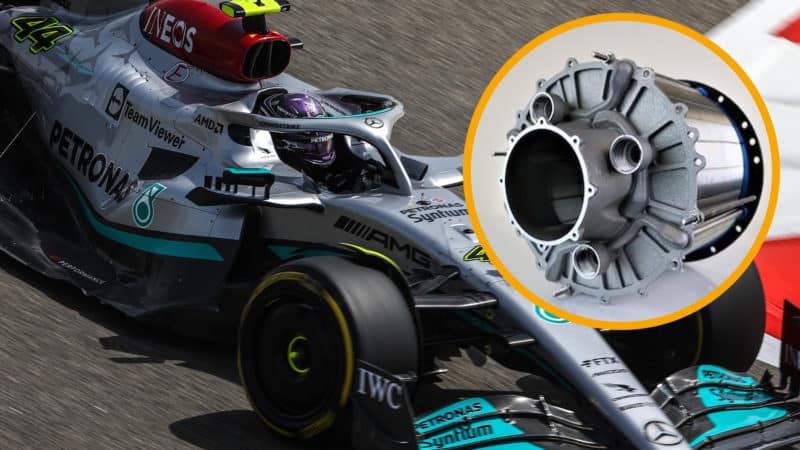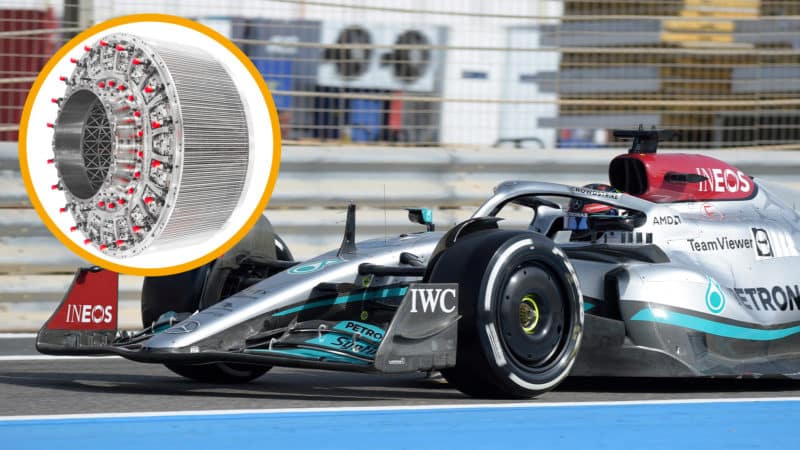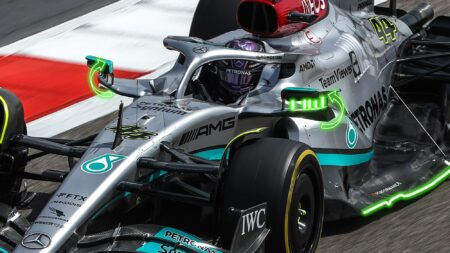Since 2014, Mercedes has used an air-water charge cooler on its power unit, whereas the majority of the rest of the field (including its customer teams) rely on air-air cooling. This is an important area of development as it affects not only the potential power output of the engine, but also its longevity and the packaging of various coolers within the car.
To briefly explain, air begins its journey to the engine’s combustion chambers via the roll-hoop air inlet, where it is fed to the compressor stage of the turbocharger (on the front of the block in Mercedes’s case) where it is pressurised.
The point of compressing the air is to squeeze more oxygen into the cylinder on each intake stroke and, as ultra lean burn engines, the F1 V6s need a lot of air (hence the advantage of Mercedes, and latterly Honda and now Alpine/Renault’s layouts, allowing for a larger and more efficient compressor). Having had the chance to glimpse some engine running data from Renault, the current F1 engines run at very high boost levels, in excess of 4.7 bar absolute.
However, compressing the air creates heat, lots of it, and that heat needs to be removed before the air enters the combustion chamber. Not only is hot air less dense, achieving stable combustion at very lean mixtures (with both spark initiated and compression ignition) is reliant on maintaining cylinder and charge temperatures within a very specific window. If the air is too hot, detonation (uncontrolled ignition of the mixture) quickly becomes a catastrophic problem.

Air from roll-hoop inlet is compressed and needs cooling
This is where the charge cooler comes in, whose job is to take as much heat out of the air as possible. In the case of the aforementioned Renault engine, the outlet air temperature at the compressor is in the region of 220C, which is dropped to around 55C by the time it reaches the manifold. The most common approach is to use an air-air heat exchanger, where the charge air is passed through a radiator that sits in the cooling airflow. This approach is relatively straightforward but is not the most efficient method; air is relatively poor at conducting heat. It also necessitates the air taking a circuitous path from turbo to inlet, increasing inertia in the inlet system, not to mention requiring extensive pipework to be packaged.
In order to remove enough heat, a large air-air cooler is needed. The ideal shape for such as cooler is very thin with a large frontal area. The rules of thermodynamics show that heat transfer is highest when the temperature difference between the coolant and fluid it is cooling (air in this case) is greatest – normally referred to as Delta Δ/T. As the cooling air passes across the cooler, it heats up, reducing the temperature delta between it and the fluid being cooled, meaning less heat is removed. If one had two coolers with the same surface area, but one wide and thin, the other narrow and thick, the former would remove more heat.
This is where air-water cooling comes in. Water is one of the most efficient cooling mediums going, so it can be used to cool the charge air far more effectively for a given cooler size, bringing both packaging and charge temperature benefits. Water’s specific heat capacity is 4200 Jkg-1K-1 and air’s is 993 Jkg-1K-1, meaning it has over four times the specific heat capacity of air.
In an air-water charge cooler, air is passed over a matrix of very thin walled (to maximise heat transfer) tubes filled with coolant. The problem is that though more efficient, such coolers are hard to engineer and make reliable, not least when it comes to ensuring none of the joints between tiny coolant pipes leak. Mercedes has always pursued this path and reaped the performance and packaging benefits. However, F1 technical director Pat Symonds suggested during the second test that Mercedes is now using a more advanced (read more efficient and smaller) cooler than previously.

Reaction Engines’ water-cooled intercooler (inset)
The cooler in question uses technology developed by a UK company called Reaction Engines, which is working on the development of air breathing rocket motors. These engines have a similar requirement to a turbocharged gasoline engine in that incoming charge air is compressed and needs cooling, but to a much higher degree. The engines are designed to hurtle through the air at five times the speed of sound, with this forward speed helping to ram air into the engine inlet, heating it to around 1000°C in the process. Reaction Engines had to develop what it calls a pre-cooler to drop this temperature back down to ambient levels, and it turns out the technology has lots of uses beyond rockets – including F1.







